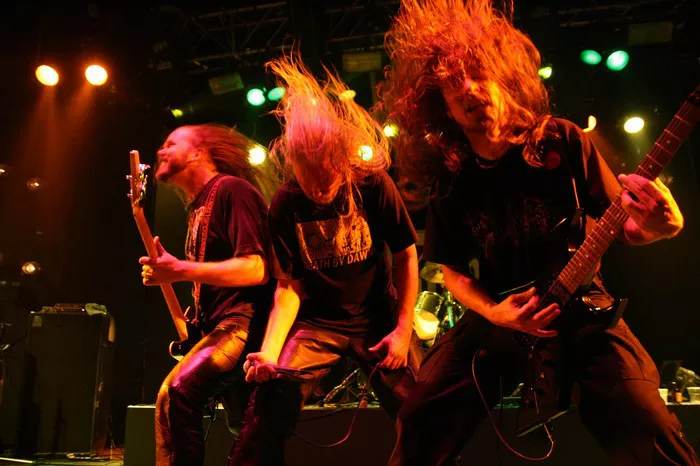In the ever-evolving landscape of heavy metal, a new subgenre has emerged, one that challenges traditional boundaries and pushes the limits of sonic experimentation. Djent, a term derived from the distinctive percussive sound it creates, has captivated audiences worldwide with its unique fusion of crushing riffs, intricate rhythms, and an unwavering commitment to innovation. This article delves into the enigmatic world of djent metal music, exploring its origins, distinctive characteristics, and the artists who have propelled this cutting-edge genre to the forefront of the metal scene.
The Birth of a New Sound
The origins of djent can be traced back to the early 2000s, when a new generation of metal musicians began experimenting with digital recording techniques and unconventional guitar tones. The distinctive “djent” sound, characterized by its staccato, percussive quality, was initially an unintended byproduct of palm-muted guitar riffs combined with heavily distorted and digitally processed tones.
This unique sonic signature quickly caught the attention of metal enthusiasts, sparking a wave of interest and exploration within the genre’s underground circles. As the internet facilitated the rapid exchange of ideas and new music, djent began to take shape as a distinct subgenre, transcending its humble beginnings and evolving into a full-fledged movement.
Deconstructing the Djent Sound
At the core of djent lies a relentless pursuit of rhythmic complexity and tonal experimentation. The genre’s signature sound is characterized by heavily palm-muted, down-tuned guitar riffs that create a percussive, staccato effect. These riffs are often accompanied by intricate drumming patterns, incorporating polyrhythms, odd time signatures, and intricate syncopation, challenging the boundaries of traditional metal songwriting.
Djent musicians are known for their unwavering commitment to tone crafting, meticulously sculpting their guitar and bass tones to achieve a unique and instantly recognizable sound. The extensive use of pitch-shifting, digital processing, and advanced amplifier modeling techniques has become a hallmark of the genre, allowing artists to explore uncharted sonic territories.
Moreover, djent’s blend of aggression and groove has given rise to a distinctive rhythmic sensibility, blurring the lines between metal and other genres like progressive rock and jazz fusion. This fusion of influences has resulted in a sound that is both viscerally heavy and intricately nuanced, appealing to fans of both technical proficiency and sheer sonic power.
Pioneering Artists and Their Lasting Legacy
While djent’s origins can be traced back to various underground scenes, a handful of pioneering artists have played a pivotal role in shaping and popularizing the genre. Among them, bands like Meshuggah, Periphery, and Animals as Leaders have left an indelible mark on the djent landscape.
1. Meshuggah: Widely regarded as the progenitors of djent, this Swedish metal juggernaut has been pushing the boundaries of extreme music since the late 1980s. Their groundbreaking album “Chaosphere” (1998) is often cited as a crucial influence on the genre, with its polymetric rhythms, dissonant riffs, and unconventional song structures paving the way for future djent experimentation.
2. Periphery: Emerging from the bustling Washington, D.C. metal scene in the late 2000s, Periphery quickly gained a devoted following for their unique blend of djent grooves, soaring melodies, and progressive songwriting. Their debut album “Periphery” (2010) is considered a landmark release, showcasing the genre’s potential for seamlessly fusing technical proficiency with accessibility.
3. Animals as Leaders: Founded by virtuoso guitarist Tosin Abasi, Animals as Leaders has become a standard-bearer for instrumental djent. Their intricate compositions, which seamlessly blend metal, jazz, and world music influences, have captivated audiences with their sheer musicality and technical prowess, solidifying the genre’s credibility among discerning music fans.
These pioneering acts, along with countless others, have laid the foundation for a thriving djent scene, inspiring a new generation of musicians to push the boundaries of heavy music and explore uncharted sonic territories.
Fostering a Worldwide Movement
Djent’s meteoric rise can be attributed, in part, to the power of the internet and the global connectivity it has fostered. Online forums, social media platforms, and music streaming services have played a crucial role in facilitating the rapid dissemination of djent music, allowing fans and artists from around the world to connect, collaborate, and share their passion for this unique genre.
This global community has not only fueled the growth of djent but has also fostered a sense of camaraderie and mutual support among its adherents. Fans and musicians alike have embraced the DIY ethos that underpins the genre, with many artists self-producing and self-releasing their music, circumventing traditional industry channels.
Moreover, the djent community has embraced a spirit of experimentation and cross-pollination, with musicians frequently collaborating across genres and styles, pushing the boundaries of what defines djent. This openness to exploration has led to the emergence of various subgenres and offshoots, further expanding the sonic palette of the genre and ensuring its continued evolution.
Conclusion
As djent continues to captivate audiences worldwide, its future remains an exciting and enigmatic prospect. With each new release and live performance, the genre’s pioneers and rising stars push the boundaries of what is possible, redefining the very essence of heavy music.
One of the most intriguing aspects of djent’s future lies in its potential for cross-genre experimentation. As the genre’s influence continues to spread, artists from diverse musical backgrounds are increasingly incorporating djent elements into their compositions, blurring the lines between metal, electronic, and even orchestral music.
Additionally, the advent of new technologies and recording techniques promises to further shape the sonic landscape of djent. The integration of advanced synthesis, sampling, and digital signal processing could pave the way for previously unimagined timbres and textures, expanding the genre’s already vast tonal palette.

